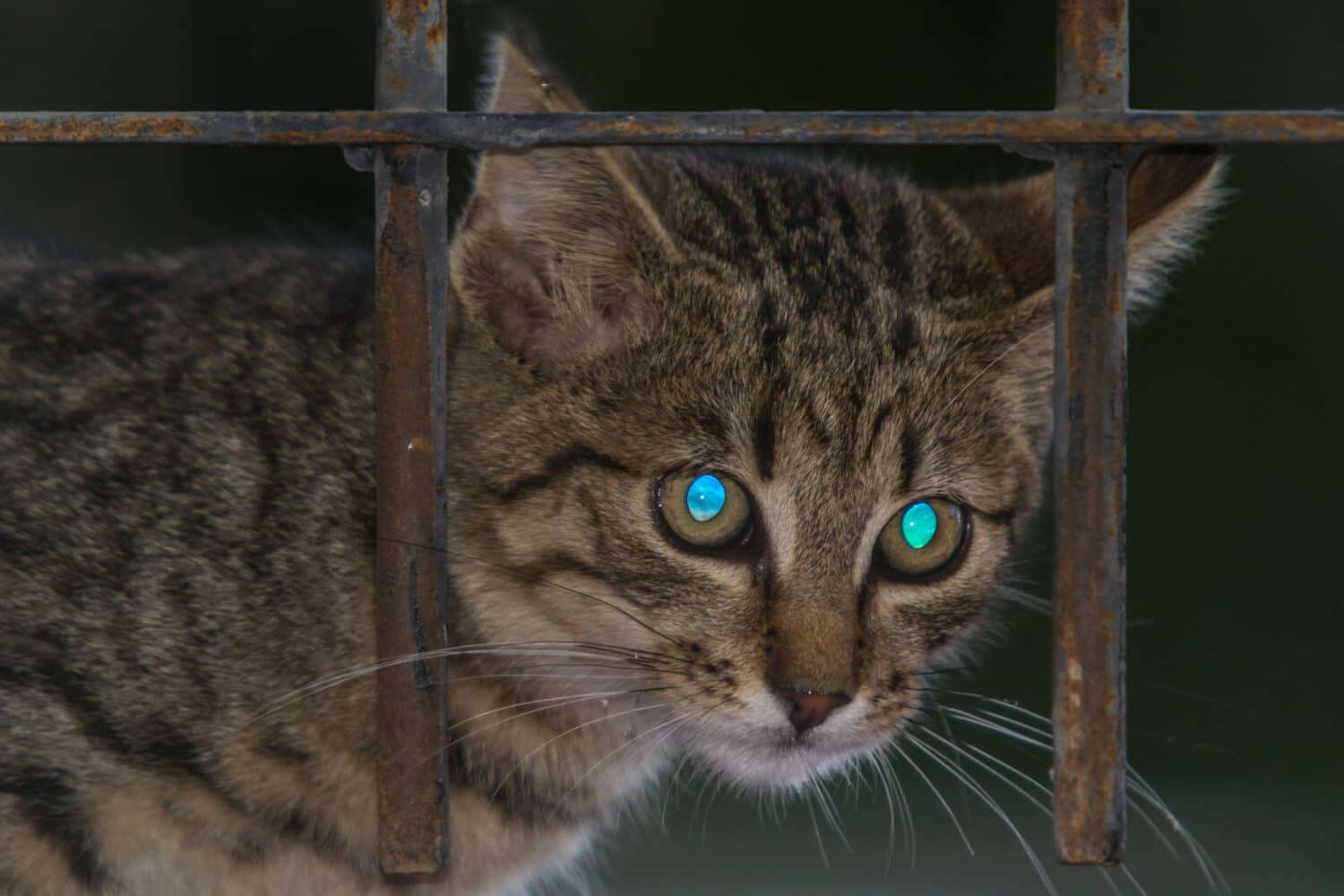Why do cats’ eyes, along with those of certain other animals, seem to glow in the dark? Anyone who’s ever tried to photograph a cat at night has probably seen this phenomenon. Does this feline trait, part of their sometimes spooky charm, serve them in some way?

Cats possess a phenomenon known as “eyeshine”, caused by a unique evolution known as the tapetum lucidum.
©Todorean-Gabriel/Shutterstock.com
The answer is that evolutionarily, yes, it certainly has. Cats, descended from big cats, have historically hunted for prey or foraged for food, often at dawn, dusk, or the dead of night. Through Darwinian evolution, the kitties best able to see in these conditions caught the most meals. Over generations, their keen eyesight was genetically rewarded, becoming an ever more common trait over time. Fast forward to today, and your average house cat can see clearly in visibility that’s 16% of what their owner would need to keep from stubbing their toes. (Maybe this goes a way to explaining cats’ love for midnight zoomies.)
The Optical Science Behind Feline Super-Sight
So that’s why cats can see so well. Now, how do they accomplish it? Turns out, it’s all in the pupils — the middle, darkest part of the eye. Pupils widen or narrow depending on the brightness of what they are looking at. The wider the pupil, the more it can compensate for low-light conditions — and a cat’s pupil can widen up to 50% more than a person’s can. Meanwhile, in the back of the eye, there are cells known as rods and cones. Rods catch the lowest light, and cats have more of these, as well.
A Unique Body Part: the Tapetum Lucidum
But even without broader pupil apertures and extra rods, cats would still be super-sighted thanks to a body part they have that most species don’t: it’s called the tapetum lucidum — that’s Latin for “shining tapestry”. The tapetum lucidum is a thin layer of tissue that sits just behind a cat’s retina, the part of the eye that translates light into electrical “information” for the brain.
Cats big and small possess this membrane, which is made up of mirror-like crystal formations of riboflavin, also known as Vitamin B2. The tapetum thus reflects light from outside the eye back to the retina. The riboflavin strengthens the light to a visual wavelength that cats can make out clearly.
The tapetum has a chameleon-like quality, too: it will adapt its color, depending on the wavelength of the light the cat is viewing. A cat’s tapetum lucidum and iris can shine gold, yellow, orange, green, or blue.
The Tapetum Lucidum in Other Animals
While not all animals possess a tapetum lucidum, cats aren’t the only animals who do. Both carnivorous and herbivorous animals can have one. For example, both foxes and sheep share this trait.
Several water-dwellers benefit from a tapetum, aiding their eyesight in the sometimes murky depths. (Light travels more slowly through water than air, meaning the darkest places on our planet are underwater.) In addition to fish, dolphins, which are mammals, have a tapetum lucidum.
Also due to evolution, the tapetum of a water animal is slightly different than that of a land-based creature: on land, where animals need to see what is on the ground, the tapetum sits behind the retina at the top half of the eye. But animals that live in water aren’t so floor-focused: because the things they need to see could come from any direction, the tapetum takes up almost the whole eye.
Does any land animal have as effective a tapetum as the domestic cat? Yes! Two species of smaller primates — lemurs and bush babies — have equivalently supercharged tapeta.
Animals Without Eyeshine
Most animals with white or very light coats and blue eyes — think of an Alaskan husky — have lost their tapeta over generations of evolution. It makes sense if you think about it: many such animals tend to hail from snowy climates, where seeing the sun too brightly could be a blinding downside. Smaller domesticated dogs also tend to lack tapeta.
But don’t judge! You don’t have one, either. No human does. Most primates — the order to which humans belong, as well as apes and monkeys — don’t. (The lemur and bush baby are exceptions.) We’re in good company with pigs, birds, and reptiles, none of which have tapeta lucida.
What Does it Mean if My Cat Doesn’t Have Eyeshine?
If you’re a cat owner and notice that your pet’s eyes don’t shine in dim lighting, it’s worth taking them to the veterinarian to rule out a vision problem. Cats can develop eyesight problems such as conjunctivitis, cataracts, or glaucoma. A lack of eyeshine in your cat could be a symptom of one or more of these problems.
The Eyeshine Trade-off
Nothing is free in this world — not even the tapetum lucidum, it turns out. Animals who possess the internal “night vision goggles” see somewhat less well in bright light conditions. That tracks: so much light is reflected by eyeshine, a cat’s vision gets a tad blurrier during sunlight hours. (That’s why their pupils narrow so much at these times.) In a bright space, a cat would need to be seven times closer to a given object than a person would to see it equally clearly.
The photo featured at the top of this post is © Konstantin Zaykov/Shutterstock.com
Thank you for reading! Have some feedback for us? Contact the AZ Animals editorial team.







